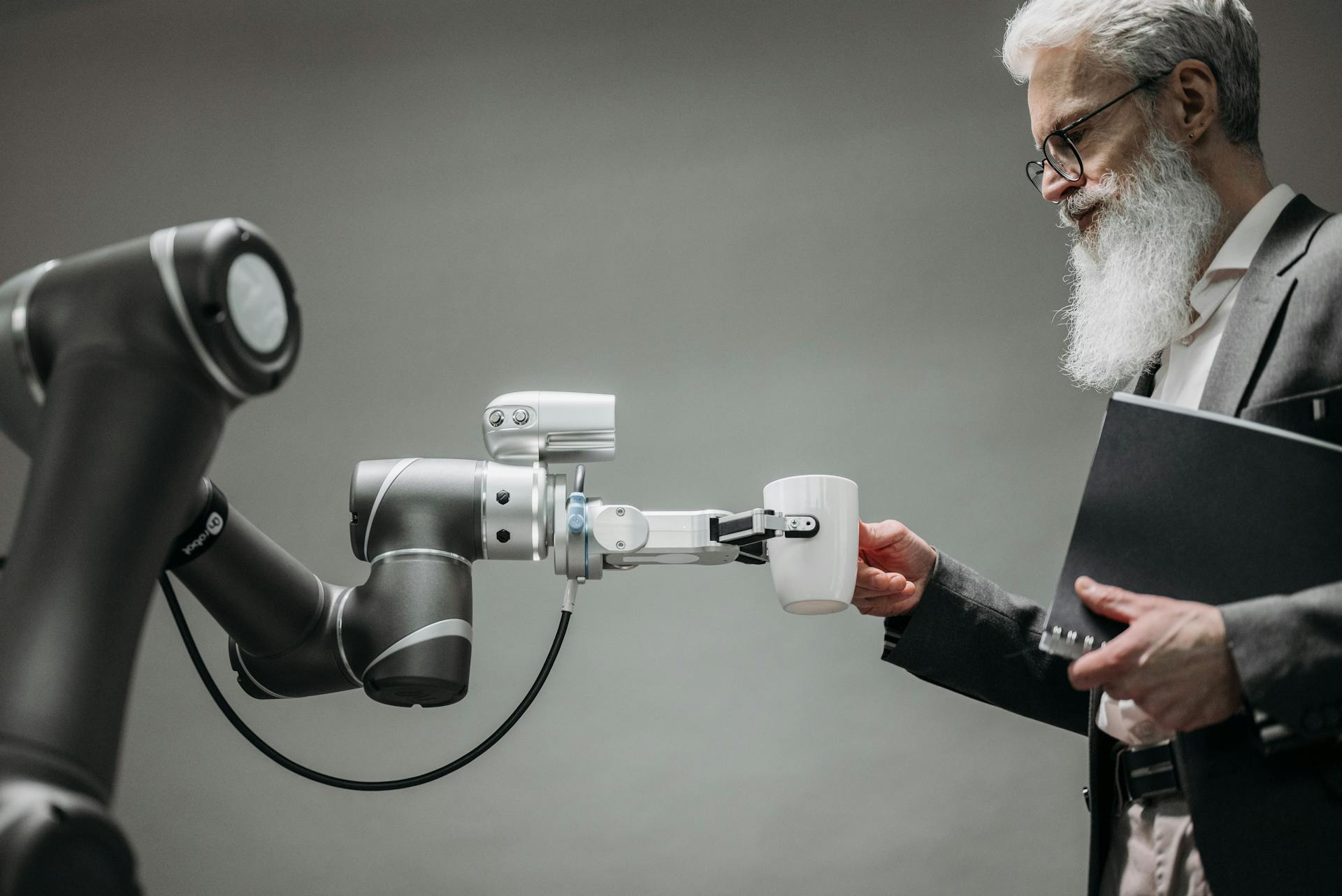
Artificial intelligence is transforming the way we work, and it's happening faster than you think. According to a recent study, AI adoption is expected to reach 70% by 2025.
This shift brings both opportunities and challenges. On the one hand, AI can automate repetitive tasks, freeing up employees to focus on more creative and strategic work. On the other hand, it's also likely to displace certain jobs, especially those that involve routine or manual labor.
The World Economic Forum predicts that by 2022, more than 75 million jobs will be displaced due to automation. However, it's also estimated that 133 million new roles will emerge that require skills we don't yet have.
Worth a look: How Generative Ai Will Transform Knowledge Work
The Future of Work
The Future of Work is looking bright, thanks to AI-driven transformations. This shift is leading to increased productivity, innovation, and collaboration for organisations.
Businesses can leverage AI to focus on outcomes rather than outputs, generating greater value and exciting new opportunities for all stakeholders. This approach allows companies to think creatively and make the most of their resources.
To integrate AI seamlessly into the workplace, organisations can start by enhancing human capabilities. This can be achieved by automating mundane tasks, freeing up employees to focus on more complex and creative work.
The future of work is all about collaboration and efficiency. AI is being integrated into workplace processes and communication to revolutionise the way we work. This is making work more engaging and fulfilling for employees.
However, this future also requires ethical AI design and policies to ensure a fair transition. Organisations must consider the impact of AI on their workforce and implement measures to mitigate any negative effects.
Here are some key measures to consider when integrating AI into the workplace:
- Leverage AI to shift focus from outputs to outcomes
- Automate mundane tasks to enhance human capabilities
- Integrate AI into workplace processes and communication
- Implement ethical AI design and policies
Automation's Impact on Labor
Automation is changing the labor market at an unprecedented rate. The labor market is evolving faster than ever before due to artificial intelligence, with no job category immune to change.
Rise in demand for tech-savvy professionals is a direct result of businesses leaning heavily on digital transformation powered by automation and machine learning technologies. This has led to a surge in opportunities for those who can navigate this brave new world.
New career paths are emerging, such as ethical hacking, data science, cybersecurity analysis, and AI ethics consultancy. These careers are now at our doorstep thanks to technological progressions driven by AI.
Labor markets are flexing their muscles, with every leap in productivity brought forth by automation adoption across sectors like manufacturing or service industries. This shift subtly yet significantly towards areas where machines can't tread...yet.
A McKinsey report laid down the facts: while some jobs get displaced due to automation technologies, new roles emerge elsewhere that weren't even on our radar before. It's this delicate dance between losing old jobs but gaining new ones that keeps economists up at night.
By 2030, an estimated 14% of folks globally might need to switch lanes job-wise due to these shifts. But history shows us that adaptability is key – new occupations sprout up like wildflowers after rain.
Jobs created vs jobs lost: Yes, some roles will fade away, but think about how many didn't exist ten years ago? Content creators anyone?
The midpoint scenario impact: This shift doesn't mean mass unemployment; rather an opportunity for re-skilling into burgeoning fields.
You might like: New Artificial Intelligence Program
Here are some key statistics to keep in mind:
Automation's impact on labor is complex, with both positive and negative effects. While it boosts productivity and drives labor substitution in some sectors, it also leads to job displacement and raises concerns about security, privacy, and decision-making biases.
Technological Advancements
Technological advancements are happening at an incredible pace, and it's changing everything. Automation isn't new, but it's taking leaps forward, revolutionizing the nature of our jobs and unlocking possibilities for breakthroughs we've scarcely imagined.
The pace of technological progress is so rapid that what was considered cutting-edge yesterday might be old news tomorrow. This means we're seeing more and more tasks flipping from manual labor to fully automated processes. It's like we're living in one of those sci-fi movies, but without the evil robots taking over.
Machine learning is the secret sauce behind many AI instruments, enabling them to analyze large data sets, reduce errors, and predict trends. With machine learning, businesses can make astute decisions effortlessly, and machines don't have bad days, so they reduce mistakes significantly.
You might enjoy: Intelligent Harmony Machine
AI tools are transforming our work environments, boosting productivity by 14%. They handle repetitive tasks nobody really likes doing, giving us humans more room to breathe and be creative. They're like that friend who insists on making dinner so you can finish up your work – helpful and indispensable.
Here are some examples of AI in the workplace:
- Predictive patient care in healthcare
- Financial fraud detection
- Customer service enhancements via chatbots
These are just a few examples of how AI is demonstrating its transformative potential across various sectors, driving efficiency and innovation.
Opportunities and Challenges
Artificial intelligence (AI) is transforming the future of work, presenting both opportunities and challenges. AI offers immense opportunities for enhancing efficiency, spurring innovation, and fostering business growth.
One of the most significant benefits of AI is its ability to automate routine tasks, freeing employees for more complex and fulfilling work. This can boost productivity and job satisfaction, as employees are able to focus on high-value tasks that require human skills like creativity and problem-solving.
However, AI also presents some complex challenges and risks, including bias, privacy concerns, job displacement, and the dangers of overreliance on digital systems. These risks must be carefully managed to ensure that AI serves to enhance our human workforce and uphold ethical standards.
Here are some key statistics on the impact of AI on job displacement and creation:
To harness the full potential of AI, organisations must adopt a strategic approach that includes continuous learning, fostering AI literacy across the organisation, committing to ethical AI usage, and promoting collaboration. This will enable businesses to stay competitive and resilient in the face of rapid technological change.
Ultimately, the future of work intertwined with artificial intelligence is a realm of endless possibilities. By leveraging AI's capabilities while nurturing human skills, we can create a future where technology augments our potential, transforming industries and fostering a more efficient and adaptable workforce.
Strategies for Integration
To successfully integrate AI into the workplace, you need to think beyond just the technology itself. Integrating AI effectively requires a holistic view that encompasses organisational culture, employee engagement, and ongoing improvement.
Securing leadership support is crucial, as it sets the tone for the entire organisation. This means getting buy-in from top executives and ensuring they understand the benefits and challenges of AI.
Engaging and training employees is also essential, as they will be the ones working with AI systems on a daily basis. Starting with pilot projects allows you to test and refine your approach before rolling out AI across the entire organisation.
Forging partnerships with other companies or experts can also help enhance AI capabilities and provide access to new technologies and expertise.
Economic and Social Implications
The economic and social implications of artificial intelligence are vast and multifaceted. As AI becomes increasingly integrated into our daily lives, we can expect significant changes in the way we work, live, and interact with one another.
AI will handle routine tasks, providing individuals with more freedom and flexibility to pursue their interests and passions. This shift in focus will lead to a more fulfilling and meaningful life, as people are able to pursue their personal goals without being bogged down by mundane tasks.
See what others are reading: How Will Artificial Intelligence Affect the Future
The augmented intelligence economy will create new job opportunities, while also enhancing existing roles. This economic paradigm prioritizes AI ethics and regulation to ensure transparency, fairness, and accountability.
Continuous learning will become a cornerstone of this new economy, with AI providing personalized education, real-time feedback, and access to vast resources and information. This will enable individuals to adapt and evolve in a rapidly changing world, staying ahead of the curve and achieving their full potential.
The pace of technological progress is accelerating at an unprecedented rate, revolutionizing the nature of our jobs and unlocking possibilities for breakthroughs we've scarcely imagined. Automation is changing everything from our job routines to our leisure activities, signaling a shift that we ought to notice.
The future of work will be shaped by the augmented intelligence economy, which will enable self-directed living, continuous learning, and new job opportunities. By embracing this new paradigm, we can create a brighter, more prosperous future for all.
A fresh viewpoint: Artificial Intelligence and the Future of Teaching and Learning
Education and Regulation
Education and Regulation play a crucial role in shaping the future of work with AI. To prepare the workforce for the exciting opportunities AI presents, innovative educational approaches can integrate AI tools, theories, and topics into curricula to inspire and prepare students. Employers have a responsibility to foster education and cultivate adaptability towards digital and AI enablement.
Upskilling programs tailored specifically for those hit hardest by automation can ensure nobody is left behind as industries evolve. Educating the workforce is just one part of the solution, as strategic interventions like innovation and social safety nets are also essential. Encouraging businesses to innovate creates opportunities beyond traditional roles affected by automation, such as AI ethics specialists or data analysts navigating through seas of big data.
The regulation of AI development and deployment is also crucial. A proper AI governance framework can enable companies and governments to harness the full potential of AI while ensuring ethical development. This can be achieved through a standard naming convention for AI systems, registering AI research, and defining ethical boundaries in AI applications.
Revamping Education for the Workforce
Educational approaches need to change to support the work of the future, and AI can be a game-changer in this area. Innovative educational approaches can prepare the workforce for the exciting opportunities AI presents.
Employers have a responsibility to foster education and cultivate adaptability towards digital and AI enablement. This can be achieved through upskilling programs tailored specifically for those hit hardest by automation.
Upskilling programs can ensure nobody is left behind as industries evolve. Encouraging businesses to innovate creates opportunities beyond traditional roles affected by automation.
Social safety nets need beefing up too because transition periods can be tough without them. Providing adequate support ensures individuals have something soft to land on when their industry takes an unexpected turn towards full-on automatization.
The world isn't slowing down, and neither should your learning curve. AI-driven platforms can spot your weak spots before you do and turn them into strengths.
Here are some ways AI can be integrated into educational curricula to inspire and prepare students for the future workforce:
- AI-driven platforms that adapt to you
- Voice assistants that can teach you new skills
- Personalized learning experiences that feel like they're crafted just for you
Embracing AI tools can significantly amp up productivity and skill acquisition. By integrating AI into educational curricula, we can inspire and prepare students for the future workforce.
The workers' skills gap can be bridged through targeted training programs. These programs can be crafted with AI's precision to fill gaps efficiently.
Here are some features of targeted training programs:
- Diagnostics tests that pinpoint what needs brushing up on
- Skill-specific courses designed by understanding how people learn best
- Mentorship from afar, guided by experts worldwide
The goal of these programs is to make sure everyone has access to opportunities for growth regardless of their starting point.
What Do We Need from Regulation?
So, what do we need from regulation? We need a proper AI governance framework that enables companies and governments to harness the full potential of AI while ensuring ethical development.
This framework should include a standard naming convention for AI systems to promote transparency and trust in AI applications. Transparency is key to building trust in AI, and a standard naming convention can help achieve this.
We also need to register AI research and document requirements to contribute to responsible and innovative AI development. This will help ensure that AI is developed and deployed in a way that benefits society.
Defining ethical boundaries in AI applications is crucial to protect society while encouraging innovation. This will require a clear understanding of what is acceptable and what is not in AI development.
Accountability for the use and governance of AI is a complex issue. It's not just the responsibility of the CDIO/CIO, individuals using AI, or the team who trained the AI. It's a shared responsibility that goes wider than that to other parties, such as HR and legal departments.
Here are some key questions to consider when thinking about accountability for AI:
- Who is responsible for ensuring AI is developed and deployed in a responsible and ethical manner?
- How can we ensure that accountability for AI is shared across different departments and stakeholders?
The Role of AI
AI is changing the workforce by automating routine tasks and augmenting human capabilities, increasing productivity across various industries. This can alleviate the shortage of skilled workers and make tasks more manageable.
Demographic trends, such as baby boomers retiring and young workers not arriving in sufficient numbers, contribute to the critical shortage of skilled workers. This highlights the importance of extensive digital education and leadership development.
AI can enable human cognitive state monitoring and robot control strategy adaptation for improving human comfort, ergonomics, and trust in automation. This is achieved through vision-based cognitive load assessment integrated into collaborative robotic technologies.
A new breed of leadership is required in the AI-driven era, one that transcends traditional hierarchical and matrix structures. This distributed leadership model fosters fluidity and adaptability, allowing individuals with relevant skills or expertise to take charge when needed.
AI can enhance human skills and collaboration at work, leading to more personalised learning, improved decision-making, and better communication and project management. This is achieved through collaborative leadership that bridges the gap between AI and human collaboration.
Here are some key benefits of AI in the workforce:
- AI tools might alleviate the shortage of skilled workers by automating routine tasks and augmenting human capabilities.
- AI can enhance human skills and collaboration at work, leading to more personalised learning, improved decision-making, and better communication and project management.
- Distributed leadership is an approach that emphasises collaboration and shared responsibility among individuals with relevant skills or expertise.
Sources
- https://ssir.org/articles/entry/ai-impact-on-jobs-and-work
- https://www.bcs.org/articles-opinion-and-research/ai-and-the-future-of-work/
- https://www.linkedin.com/pulse/future-work-how-ai-reshape-our-workplaces-emmanuel-ramos-ansse
- https://powell-software.com/resources/blog/ai-and-the-future-of-work/
- https://www.trainingjournal.com/2024/content-type/opinion/shaping-the-future-of-work-with-artificial-intelligence/
Featured Images: pexels.com


